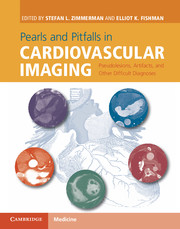 Pearls and Pitfalls in Cardiovascular Imaging
Pearls and Pitfalls in Cardiovascular Imaging from Section 11 - Veins
Published online by Cambridge University Press: 05 June 2015
Imaging description
Catheter malpositions are found by identifying the tip of the venous or arterial catheter in the incorrect position, either within the incorrect vessel, or advanced too far or too short for acceptable use (Figures 92.1 to 92.4). Malpositions can occasionally be challenging to identify on radiographs due to overlying structures; however, they can typically be resolved with adjustments to brightness and contrast. Catheter malpositions are easily identified by cross-sectional imaging but are not uncommonly missed due to reader oversight.
Importance
Central venous catheterization is commonly used in modern medicine for various purposes; however, more than 15% of patients who receive these catheters have complications. These complications include mechanical and chemical injury to the vessel wall with thrombus formation, development of a fibrin sheath, infection, and misplacement into other vessels.
Malposition of central venous catheter placement may occur when advancing a catheter into an incorrect vein, or extending a catheter too far distally within a vessel. Malposition of a central venous catheter can result in complications including thrombosis, and vascular perforation or even cardiac perforation and pericardial tamponade. Positioning a catheter tip into the right atrium is thought to increase the likelihood of cardiac arrhythmias. It is important to detect malposition of a central venous catheter on imaging studies.
Typical clinical scenario
There is controversy regarding the correct position for the tip of a central venous catheter. When a catheter is placed from the internal jugular vein or upper extremity veins, the traditional approach has been to place the tip of the central venous catheter within the superior vena cava; however, many believe that the performance and durability of the catheter will be improved by positioning the catheter tip within the upper right atrium. Catheter malposition may occur in the azygos vein, hemiazygos vein, internal mammary vein, or contralateral innominate vein. Positioning of the catheter in an anomalous vein or a venous collateral may occur, including persistent left superior vena cava, dominant supreme intercostal vein, and pericardiophrenic vein. In patients with central vein occlusion due to thrombus or external compression, a central venous catheter may be advanced to an unintended position.
To save this book to your Kindle, first ensure [email protected] is added to your Approved Personal Document E-mail List under your Personal Document Settings on the Manage Your Content and Devices page of your Amazon account. Then enter the ‘name’ part of your Kindle email address below. Find out more about saving to your Kindle.
Note you can select to save to either the @free.kindle.com or @kindle.com variations. ‘@free.kindle.com’ emails are free but can only be saved to your device when it is connected to wi-fi. ‘@kindle.com’ emails can be delivered even when you are not connected to wi-fi, but note that service fees apply.
Find out more about the Kindle Personal Document Service.
To save content items to your account, please confirm that you agree to abide by our usage policies. If this is the first time you use this feature, you will be asked to authorise Cambridge Core to connect with your account. Find out more about saving content to Dropbox.
To save content items to your account, please confirm that you agree to abide by our usage policies. If this is the first time you use this feature, you will be asked to authorise Cambridge Core to connect with your account. Find out more about saving content to Google Drive.